Chapter 5 Mass Media and History Notes, Textbook Exercise Important Questions and Answers.
Mass Media And History Class 10 Question 1.
(A) Choose the correct option from the given options and complete the statement.
(1) The first English newspaper in India was started by ………………………….. .
(a) James Augustus Hickey
(b) John Marshall
(c) Allen Hume
Answer:
(a) James Augustus Hickey
(2) Television is an ………………………….. medium.
(a) visual
(b) audio
(c) audio-visual
Answer:
(c) audio-visual
(B) Identify and write the wrong pair in the following set.
(1) ‘Prabhakar’ – Acharya P.K. Atre
(2) ‘Darpan’ – Balshastri Jambhekar
(3) ‘Deenbandhu’ – Krishnarao Bhalekar
(4) ‘Kesari’ – Bal Gangadhar Tilak
Answer:
(1) Wrong Pair: ‘Prabhakar’ – Acharya P.K. Atre
Mass Media And History Class 10 Question 2.
Write short notes :
(1) The role of newspaper in the Indian struggle for independence
Answer:
Newspapers played an important role in the Indian independence struggle. It is as follows
(2) Why do we need mass media?
Answer:
Mass media includes print and electronic and various new media.
(3) Mass Media and professional opportunities.
Answer:
There are many professional opportunities available in printed, electronic and digital media.
Mass Media And History Class 10 Question Answer Question 3.
Explain the following statements with reasons.
(1) Any information received through mass media needs to be reviewed critically.
Answer:
(2) Knowledge of history is essential for newspaper articles.
Answer:
(3) Television is the most popular medium.
Answer:
Therefore, the television is the most popular medium.
Class 10 History Chapter 5 Questions And Answers Ssc Board Question 4.
Read the following extract and answer the questions.
Radio: ‘Indian Broadcasting Company’ (IBC), a private radio company was the first one to broadcast daily programmes. Later the same company was taken over by the British Government and named as, ‘Indian State Broadcasting Service (ISBS). On 8th June 1936 it was renamed, as ‘All India Radio (AIR)’.
After Independence, AIR became an integral part of the Ministry of Information and Broadcasting (India). Initially, it broadcasted Governmental programmes and schemes. It was named as ‘Akashvani’ on the suggestion of the famous poet Pandit Narendra Sharma. Akashvani broadcasts various entertainment, awareness creating and literary programmes. It also broadcasts special programmes for farmers, workers, the youth and women. The ‘Vividh Bharati’ programmes are broadcasted in 24 regional languages as well as 146 dialects of Indian languages. Lately, various new channels like ‘Radio Mirchi’ are providing radio services.
(1) Akashavani (AIR) is an integral part of which ministry?
Answer:
(2) What was the new name of IBC?
Answer:
Indian Broadcasting Company (IBC) was taken over by the British Government. It was named as the Indian State Broadcasting Services. (ISBS). On 8th June 1936, it was renamed as ‘All India Radio’ (AIR).
(3) In how many regional languages and local dialects are ‘Vividh Bharati’ programmes broadcasted?
Answer:
People get access to news through social media like Twitter, Instagram, Facebook, YouTube and from web news portals, web channels. This information is available in English and many other languages.
(4) How AIR was named ‘Akashavani’?
Answer:
AIR was named as Akashvani on the suggestion of the famous poet Pandit Narendra Sharma.
Question 5.
Complete the following concept chart.
| Newspapers | Radio | Television | |
| Beginning/Background | |||
| Nature of information/programmes | |||
| Functions |
| Newspapers | Radio | Television | |
| Background/Beginning | James Augustus Hickey started Calcutta General Advertiser or Bengal Gazette on 29th January, 1780. It was the first newspaper in English. | A private radio station was started known as Indian Broadcasting Company. | First Doordarshan centre was started in Delhi. |
| Information Programmes | News, articles, columns, opinions of the people, editorials, advertisements etc. are published. | Along with entertainment programmes, have literary, informative programmes on farmers, women and educative values. | Events around the world, movies, music, information about environmental and historical places, sports are shown either live or recorded. |
| Functions | (1) Report daily news (2) Public awareness and mass education. (3) Provide information and strengthen democracy. (4) Oppose injustice and give publicity to developmental work. |
(1) Provide news from different sectors. (2) Entertain through music, dramas, songs, etc. (3) Present social problems and educate the masses about it. (4) Conduct discussions on various issues ranging from the environment to culture. |
(1) Telecast daily events and entertain. (2) Educate the masses. (3) Publicise programmes which are for social benefit. (4) Bring about social awakening opposing evil traditions and practices. |
Write a review of a historical serial that you have watched.
Memory Map
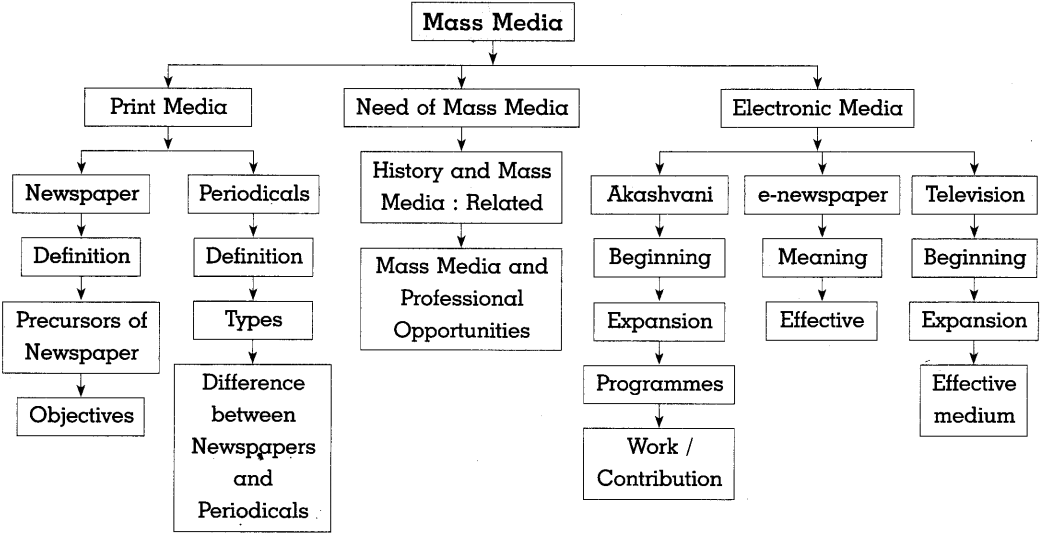
Question 6.
Complete the sentences by choosing a correct option:
(a) ………………….. is the first newspaper in Marathi.
(a) Deenbandhu
(b) Prabhakar
(c) Darpan
(d) Kesari
Answer:
(c) Darpan
(b) 6th January is celebrated as ………………….. day in Maharashtra.
(a) Periodical Day
(b) Newspaper Day
(c) Printing Day
(d) Journalist Day
Answer:
(d) Journalist Day
(c) The letters ‘Shatpatre1 published in Prabhakar were written by ………………….. .
(a) Lokmanya Tilak
(b) Lokhitvadi
(c) Mahatma Gandhi
(d) Justice Ranade
Answer:
(b) Lokhitvadi.
(d) The honour of printing illustrations for the first time in an Indian newspaper goes to ………………….. .
(a) Dnyanoday
(b) Darpan
(c) Prabhakar
(d) Kesari
Answer:
(a) Dnyanoday
(e) Deenbandhu was started by ………………….. who was a close associate of Mahatma Phule.
(a) Dr. Babasaheb Ambedkar
(b) Lokmanya Tilak %
(c) Narayan Meghaji Lokhande
(d) Krishnarao Bhalekar
Answer:
(d) Krishnarao Bhalekar
(f) ………………….. newspaper was started by Agarkar and Lokmanya Tilak.
(a) Deenbandhu and Induprakash
(b) Darpan and Prabhakar
(c) Dnyanoday and .Digdarshan
(d) Kesari and Maratha
Answer:
(d) Kesari and Maratha
(g) Balshastri Jambhekar started ………………….. the first monthly magazine in Marathi.
(a) Digdarshan
(b) Prabhakar
(c) Darpan
(d) Dnyanoday
Answer:
(a) Digdarshan
(h) ………………….. was acknowledged as the fourth pillar of democracy.
(a) Representatives
(b) Periodicals
(c) Newspaper
(d) Books
Answer:
(c) Newspaper.
(i) The first English news bulletin was broadcast on 23rd July, 1927 from the …………………… radio station.
(a) Kolkata
(b) Madras
(c) Mumbai
(d) Dblhi
Answer:
(c) Mumbai
(j) Dr. Rajendra Prasad, the first President of India inaugurated the …………………… Doordarshan centre.
(a) Mumbai
(b) Bangalore
(c) Lucknow
(d) Delhi
Answer:
(d) Delhi
(k) Newspapers published special supplements or a special issue to commemorate occasions like completion of seventy-five years of …………………… in 2017.
(a) Khilafat Movement
(b) Non Co-operation Movement
(c) Civil Disobedience Movement
(d) Quit India Movement
Answer:
(d) Quit India Movement
(l) ……………………, a German weekly magazine, had purchased a number of so called handwritten diaries that were later proved forged.
(a) Time Magazine
(b) Statesman
(c) Stern
(d) Reuters
Answer:
(c) Stern
(m) Akashvani has preserved recordings of all speeches delivered by the …………………… on 15th August.
(a) President
(b) Wee President
(c) Prime Minister
(d) Army General
Answer:
(c) Prime Minister
(n) Akashwani comes under the Ministry of …………………… of the Indian Government.
(a) Social welfare
(b) Human Resource and Development
(c) Information and Broadcasting
(d) Education Technology
Answer:
(c) Information and Broadcasting.
Question 7.
Identify the wrong pair in the following and write it:
| Newspaper | Editor |
| (1) Prabhakar (2) Darpan (3) Deenbandhu (4) Kesari | (a) Acharya R K. Atre (b) Balshastri Jambhekar (c) Krishnarao Bhalekar (d) Bal Gangadhar Tilak |
(3) Deenbandhu
(4) Kesari
(b) Balshastri Jambhekar
(c) Krishnarao Bhalekar
(d) Bal Gangadhar Tilak
Answer:
Wrong pair: Prabhakar – Acharya R K. Atre
(2)
| Newspaper | Issues |
| (1) Prabhakar (2) Induprakash (3) Deenbandhu (4) Kesari | (a) History of French revolution (b) Advocated widow remarriage (c) Information on Telegraph (d) Voiced social and political problems. |
(3) Deenbandhu
(4) Kesari
(b) Advocated widow remarriage
(c) Information on Telegraph
(d) Voiced social and political problems.
Answer:
Wrong pair Deenbandhu – Information on Telegraph
(3)
| Newspaper/Magazine/Book | Editor |
| (1) Pragati | (a) Tryambak Shankar Shejwalkar |
| (2) Digdarshan | (b) Narendra Sharma |
| (3) Deenbandhu | (c) Krishnarao Bhalekar |
| (4) Discovery of India | (d) Pandit Nehru |
Wrong pair: Digdarshan – Narendra Sharma
Question 8.
Do as directed:
(a) Complete the graphical description
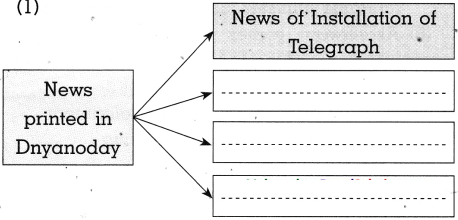
Answer:
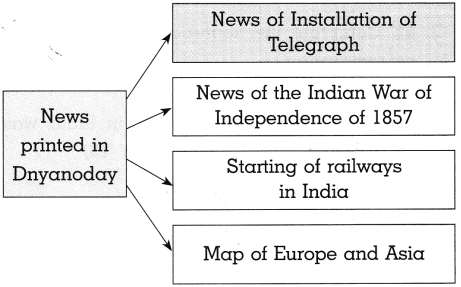
(2)
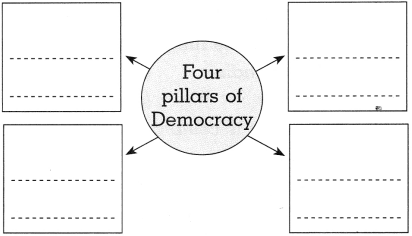
Answer:
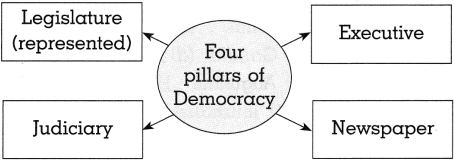
(b) Show the progress of Indian television Time-line:

Answer:

Question 9.
Explain the following concepts:
(a) Electronic or Digital Journalism or Web Journalism.
Answer:
(b) E-newspapers
Answer:
Question 10.
Write short notes:
(a) Bengal Gazette:
Answer:
(b) News printed in ‘Darpan’:
Answer:
The ‘Darpan newspaper started by Balshastri Jambhekar printed all types of news like political, economic, social and cultural. Some of them are mentioned below:
(c) Television:
Answer:
Question 11.
Explain the following sentences with reason:
(a) Newspaper is an important medium of education and information.
Answer:
(b) 6th January is observed as ‘Patrakar Din’ or ‘Journalist Day’ in Maharashtra.
Answer:
(c) Television and history are closely related.
Answer:
This shows that the knowledge of history is required in the making many of programmes on Television. Hence Television and history are closely related.
Question 12.
Answer the following question in 25-30 words:
(a) Explain the objectives of newspapers.
Answer:
The main objectives of newspapers are as follows:
(b) How is history helpful in the planning of the Akashvani programmes ?
Answer:
Akashvani broadcasts all types of programmes from celebration of independence day to entertainment programmes. In planning these programmes, the knowledge of history is essential.
(c) How were the message conveyed to the people in olden days?
Answer:
The following were a few means used to convey messages to the people in olden days:
Question 13.
Read the following passages and answer the questions:”
(a) Which programmes are broadcasted by Akashvani?
Answer:
(a) On which book is the serial ‘Bharat Ek Khoj’ based on?
Answer:
The Serial Bharat Ek Khoj is based on ‘Discovery of India’, a book written by Pandit Jawaharlal Nehru.
(b) Who directed the serial ‘Bharat Ek Khoj’?
Answer:
The serial was directed by Shyam Benegal.
(c) Which factors/aspects of Indian history are depicted in ‘Bharat Ek Khoj’? OR Why was ‘Bharat Ek Khoj’ a serial telecasted by Doordarshan admired in all parts of India?
Answer:
The television serial ‘Bharat Ek Khoj’ presented social, political and economic life from ancient to the modem period in India.
Thus, the serial effectively portrayed the journey of India from Harappan civilisation to the modern period and therefore was admired in all parts of India.
Question 14.
Answer the following questions in detail:
(a) What were the different means of communication known around the world before the advent of newspaper?
Answer:
The following means of communication were used to convey news before the advent of newspaper:
(b) Write information on Periodicals based on its types.
Answer:
Magazines and journals which are published at regular intervals are known as Periodicals.
Types:
Classification: Periodicals can be classified as popular and scholarly.
(c) Write about the important role of newspaper in the freedom struggle.
Answer:
(d) Give a short account of the development of Indian television.
Answer:
(e) Distinguish between Newspapers and Magazines.
Answer:
Newspapers and magazines differ in their format, objectives and duration of getting published. The differences are noted below:
| Newspapers | Magazines |
| 1. Newspapers document the current events. | 1. Magazines give no importance to current news. |
| 2. News, articles, columns, editorials have importance in a newspaper. | 2. Magazines give preferences to particular subject and publish articles on it. |
| 3. Newspapers are also called ‘Dailies’ as they are published every day. | 3. Duration of publication of magazine varies. Some are published weekly, fortnightly, monthly and annually. |
| 4.. The main purpose of newspaper is to report local, national and international news. | 4. Instead of providing news, their content is entertaining and knowledge-based. |
| 5. Newspapers make the people aware of the events happening in the society. They do not stick to any one subject. | 5. Magazines are about a specific topic. On the basis of their appearance, size, readability, content and audience, magazines differ from newspapers. |
| 6. Newspapers mostly write about current news. Whatever happens in the world appears in the newspaper within a span of 24 hours. It shapes public opinion and keep people updated about the activities of the government. | 6, As magazines have lot of detailed information on specific topics they are considered as historical source. |
Brain Teaser
Across:
Down: